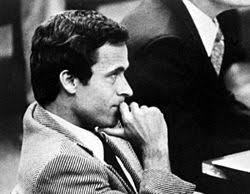Storysmith | • True Stories AND Creative Inspiration | Follow Me




THE DEVIL WITH A SMILE: THE TRUE STORY OF TED BUNDY
Part One: The Boy Next Door
He didn’t look like a killer.
That’s what they all said. Clean-cut. Charming. Polite. A little awkward at times, but nothing out of the ordinary. The kind of man your mother might have encouraged you to go on a second date with.
The truth is, Ted Bundy weaponised normal. It was his disguise, his mask. Behind that easy smile was a predator. Behind the smooth talk, a monster. And for years, he moved among us unnoticed—because monsters don’t wear horns. Sometimes, they wear a suit and hold the door open.
Ted Bundy was born on November 24, 1946, in Burlington, Vermont, to a young, unmarried mother. From the beginning, there were lies. He was raised believing his grandparents were his parents, and his mother was his sister. Later, that deception would haunt him.
As a child, Bundy was intelligent—but cold. He struggled to connect. He didn’t make friends easily. He stole. He spied. He watched women without being seen. In his teenage years, he became obsessed with pornography, particularly violent images. But he also discovered something more dangerous: he liked control.
By his twenties, Bundy had polished the mask. He was studying psychology. Volunteering at a crisis hotline. Dating. Smiling. But inside, something twisted was blooming.
Part Two: The Disappearances Begin
It started quietly.
In 1974, in Seattle, Washington, women began to vanish. Young. Brunette. Slim. Pretty. College-aged. They disappeared from dorms, libraries, parking lots. No witnesses. No struggle. Nothing but a pattern.
January 4: Karen Sparks was attacked in her bed. She survived—but barely.
February 1: Lynda Healy disappeared from her basement bedroom. Blood on the pillow. Nothing else.
March: Donna Manson, a college student, vanished after leaving her dorm for a concert.
April: Susan Rancourt vanished after attending a campus meeting.
The list kept growing.
Police had little to go on—until they got a name: Ted. A man in a brown Volkswagen Beetle had been seen approaching women, often pretending to be injured—wearing a sling, or using crutches—and asking for help.
He made women feel needed. Then he made them disappear.
By July 1974, the case exploded. On a single day, two women vanished from Lake Sammamish State Park. Witnesses saw them talking to a handsome man with his arm in a sling. He introduced himself as “Ted.”
The police had a name. They had a sketch. They had dozens of calls. And one of them came from a young woman named Elizabeth Kloepfer—Ted Bundy’s girlfriend.
But there was no hard evidence. And Bundy knew it.
Part Three: Crossing State Lines
Bundy didn’t stop. He got smarter.
In late 1974, he moved to Utah and enrolled in law school. There, the killings continued. More disappearances. More bodies in the woods. He hunted women like game.
In August 1975, a patrol officer noticed a suspicious car parked near a neighborhood. Inside the brown Beetle were handcuffs, a crowbar, rope, an ice pick—a killer’s toolkit. Bundy was arrested, but charming as ever, he talked his way out.
Police began to connect dots across state lines. Washington. Oregon. Utah. Colorado. The sketch matched. The name kept coming up. The evidence was piling.
Bundy was finally arrested again in 1976. This time, he was charged with the kidnapping of Carol DaRonch, one of the few women who got away.
But Bundy wasn’t done yet. He was just getting started.
Part Four: The Escape Artist
In 1977, while awaiting trial in Colorado, Bundy escaped from custody. Twice.
The first time, he jumped from a courthouse window. They caught him a week later.
The second time was worse. He broke through the ceiling of his jail cell, lost weight to squeeze through an opening, and walked out. It would take weeks for anyone to notice.
By then, he was in Florida.
On January 15, 1978, Bundy broke into the Chi Omega sorority house at Florida State University. In just minutes, he brutally attacked four women, killing Lisa Levy and Margaret Bowman, and severely injuring two others.
He wasn’t finished. Two weeks later, he abducted and murdered 12-year-old Kimberly Leach.
It was chaos. Brutality. Pure evil.
And it wouldn’t last much longer.
Part Five: The Devil on Trial
Bundy was arrested on February 15, 1978, by a rookie cop who pulled him over for driving a stolen car. By then, Bundy was on the FBI’s Ten Most Wanted list. His time was up.
His trial was a spectacle. Bundy represented himself, cross-examined witnesses, flirted with reporters. He smiled. Joked. Married a woman in court. But the mask was cracking.
The evidence was overwhelming:
Bite marks on Lisa Levy matched his teeth.
Survivors pointed him out in court.
Fibers. Blood. Witnesses.
He was found guilty of the Chi Omega murders and sentenced to death.
Then came the trial for Kimberly Leach. Another conviction. Another death sentence.
Part Six: The Long Wait
Bundy sat on death row for nearly a decade. He gave interviews. Confessed to more than 30 murders, though experts believe the real number is higher—possibly much higher.
He hinted at necrophilia. Torture. Decapitation. Cold, emotionless murder.
To the end, Bundy played games. Promised more confessions. Tried to delay the inevitable.
But on January 24, 1989, the switch was flipped.
At 7:16 a.m., Ted Bundy was executed in the electric chair at Florida State Prison.
Outside, a crowd cheered. Held signs. Lit fireworks.
Justice had finally come.
Epilogue: The Monster in the Mirror
Bundy was no mindless killer. He was deliberate. Intelligent. Calculated. He knew what he was doing.
That’s what makes him terrifying.
Because Bundy wasn’t the monster under the bed. He wasn’t a shadow in the alley. He was the man in line behind you. The man offering to help. The man who smiled just a little too easily.
He didn’t wear a mask. He wore your trust.
And that, perhaps, is the most chilling truth of all.

